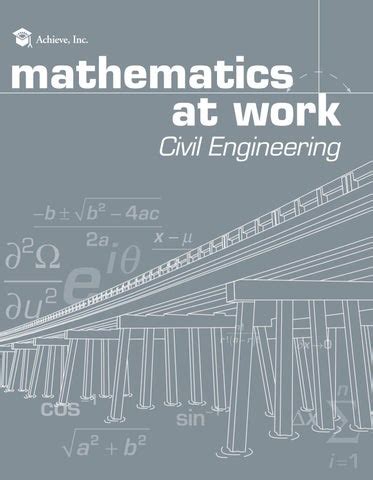Introduction
Civil engineering is a vast and complex field that encompasses the design, construction, and maintenance of infrastructure systems. From bridges and buildings to roads and water treatment plants, civil engineers play a vital role in shaping the physical environment around us. At the heart of civil engineering lies mathematics, providing the tools and techniques necessary to solve complex problems and design safe, efficient, and sustainable structures.

The Role of Mathematics in Civil Engineering
Mathematics serves as the common language of civil engineering, allowing engineers to communicate ideas and designs precisely. It provides a framework for modeling and analyzing complex systems, enabling engineers to predict their behavior under various conditions. From structural mechanics to fluid dynamics, mathematical equations and principles underpin every aspect of civil engineering practice.
Key Mathematical Concepts in Civil Engineering
The following mathematical concepts are essential for civil engineers:
- Algebra: Solving linear and nonlinear equations, matrices, vectors
- Calculus: Derivatives, integrals, differential equations
- Probability and Statistics: Data analysis, risk assessment
- Geometry and Trigonometry: Shape, angle, and distance calculations
- Numerical Methods: Solving mathematical problems numerically using computers
Applications of Mathematics in Civil Engineering
Mathematics finds its applications in virtually every aspect of civil engineering, including:
- Structural Engineering: Analyzing and designing bridges, buildings, and other structures to withstand forces and deformations.
- Geotechnical Engineering: Studying soil and rock properties to design foundations and earth structures.
- Transportation Engineering: Planning and designing roads, highways, and railways.
- Water Resources Engineering: Modeling and managing water distribution and wastewater systems.
- Environmental Engineering: Designing and operating systems for air and water pollution control.
Benefits of Mathematical Proficiency in Civil Engineering
Strong mathematical skills empower civil engineers to:
- Design safe and reliable structures: Mathematics ensures that structures can withstand the forces they will encounter in their lifetime.
- Optimize resource usage: Mathematical models help engineers design structures that use materials and energy efficiently.
- Solve complex problems: Mathematics provides the tools to analyze and solve complex problems that arise during the design and construction process.
- Innovate and stay competitive: Mathematical expertise enables engineers to develop new and innovative solutions to engineering challenges.
Challenges in Civil Engineering Mathematics
While mathematics is indispensable in civil engineering, it also presents challenges:
- Complexity of real-world problems: Real-world engineering problems are often highly complex and nonlinear.
- Need for specialized knowledge: Different branches of civil engineering require specific mathematical skills.
- Mathematical software reliance: Complex mathematical problems often require the use of specialized software.
Overcoming Challenges in Civil Engineering Mathematics
To overcome these challenges, civil engineers can:
- Develop strong mathematical foundations: A solid understanding of fundamental mathematical concepts is crucial.
- Specialize in relevant mathematical areas: Engineers can pursue graduate studies or take specialized courses to deepen their knowledge in specific areas of mathematics.
- Leverage technological advancements: Modern computational tools streamline mathematical analysis and problem-solving.
Tips and Tricks for Civil Engineering Mathematics
- Simplify problems: Break down complex problems into smaller, manageable parts.
- Use graphical representations: Diagrams and graphs can help visualize complex concepts.
- Collaborate with others: Discuss problems and solutions with colleagues, professors, or tutors.
- Practice regularly: Solving mathematical problems regularly enhances proficiency.
- Seek professional development opportunities: Attend conferences, workshops, or online courses to stay updated on the latest mathematical techniques.
Future Directions in Civil Engineering Mathematics
As the field of civil engineering evolves, mathematics will continue to play a pivotal role. Emerging trends include:
- Data analytics: Mathematical models and algorithms for analyzing large datasets will become increasingly important in predicting the behavior of structures and infrastructure systems.
- Artificial Intelligence: AI algorithms will be used to optimize designs, automate construction processes, and enhance safety monitoring.
- Sustainability: Mathematical modeling will help engineers design structures and systems that minimize environmental impact and promote sustainability.
- Digital twinning: Mathematical models will be integrated with real-time data to create digital twins of structures, enabling continuous monitoring and predictive maintenance.
Conclusion
Mathematics is the cornerstone of civil engineering, providing the foundation for safe, efficient, and sustainable infrastructure. By embracing mathematical proficiency, civil engineers can push the boundaries of innovation, solve complex problems, and shape a better future for our built environment.
